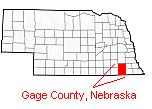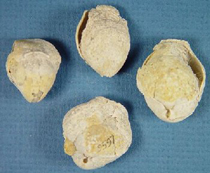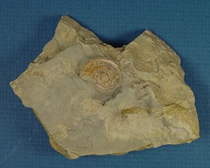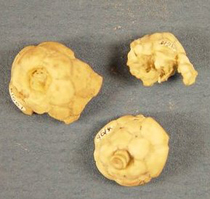As the Paleozoic drew to a close in the Permian, crinoids were becoming a much less important constituent of the earth's fauna. By the end of the Permian, the inadunate, flexible and camerate crinoids had all become extinct. Only the articulate crinoids continued through the terminal Permian extinction into the Triassic. Several species of crinoids have been collected from strata of early Permian age that are exposed in southeastern Nebraska. Pabian and Strimple described some of the Permian crinoids from Nebraska in 1974.

References
- Heckel, P. H., and Pabian, R. K., 1981. Compatibility of crinoid faunas with eustatic model for deposition of Midcontinent Pennsylvanian cyclothems [abstract]: Geological Society of america, North-central section, 15th annual meeting, abstracts with program, v. 13, no 6, 281 p.
- Holterhoff, P. F., 1988, Paleobiology and paleoecology of crinoids from the lower Stanton Formation (Late Pennsylvanian, Missourian) of the Mid-continent United States: University of Nebraska-Lincoln, Department of Geology, unpublished master's thesis, 137 p.
- Holterhoff, P. F., 1996, Crinoid biofacies in Upper Carboniferous cyclothems, midcontinent North America: faunal tracking and the role of regional processes in biofacies recurrence: Paleogeography, Paleoclimatology, and Paleoecology, v. 127, p. 47-81.
- Lane, N. G., and Webster, G. D., 1966, New Permian crinoid fauna from southern Nevada: University of California, Publications Geological Sciences, v. 63, 87 p.
- Moore, R. C., 1939, New crinoids from Upper Pennsylvanian and Lower Permian rocks of Oklahoma, Kansas, and Nebraska: Denison University, Bulletin, Journal Scientific Laboratories, v. 34, article 6, p. 171-279.
- Pabian, R. K., and Strimple, H. L., 1969: Paleoecology of Pennsylvanian crinoids from southeastern Nebraska and southwestern Iowa [abstract]: Proceedings of the Nebraska Academy of sciences, 80th annual meeting, p. 36.
- Pabian, R. K., and Strimple, H. L., 1974, Part I. Some Pennsylvanian crinoids from Nebraska: Part II. Some Permian crinoids from Nebraska, Kansas, and Oklahoma: Bulletins of American Paleontology, v. 64, no. 281, p. 249 - 337.
- Pabian, R. K., and Strimple, H. L., 1978b, Delocrinus vastus Land and Webster from the Hughes Creek Shale (Lower Permian), Richardson County, Nebraska: Journal of Paleontology, v. 52, no. 6, p. 1393.
- Pabian, R. K., and Strimple, H. L., 1985, Classification, paleoecology, and biostratigraphy of crinoids from the Stull shale (Late Pennsylvanian) of Nebraska, Kansas, and Iowa. University of Nebraska State Museum Bulletin, 11, 81 p.
- Strimple, H. L., and Moore, R. C., 1971, Crinoids of the LaSalle Limestone (Pennsylvanian) of Illinois: University of Kansas Paleontological Institute, University of Kansas Paleontological Contributions, Article 55 (Echinodermata 11), 48 p.
- Strimple, H. L., and Watkins, W. T., 1969, Carboniferous crinoids of Texas with stratigraphic implications. Paleontographica Americana, v. VI, no. 40, p. 141-275.
- (1) Newell, N. D., 1937, Late Paleozoic Pelecypods: Pectinacea: State Geological Survey of Kansas, University of Kansas, v. 10, 123 p.
- (2a) Boardman, R. S., Cheetham, A. H., and Rowell, A. J., 1987, Fossil Invertebrates: Blackwell Scientific Publicationsm Palo Alto, Oxford, London, Edinburgh, Boston, Melbourne, 713 p.
- (2b) Clarkson, E. N. K., 1986, Invertebrate palaeontology and evolution, second edition: Allen & Unwin, Boston, Sydney, 382 p.
- (2c) Miller, A. K., Dunbar, C. O., and Condra, G. E., 1933. The nautiloid cephalopods of the Pennsylvanian System in the mid-continent region: Nebraska Geological Survey, Bulletin 9, second series, 240 p.
- (2d) Newell, N. D., 1937, Late Paleozoic Pelecypods: Pectinacea: State Geological Survey of Kansas, University of Kansas, v. 10, 123 p.


